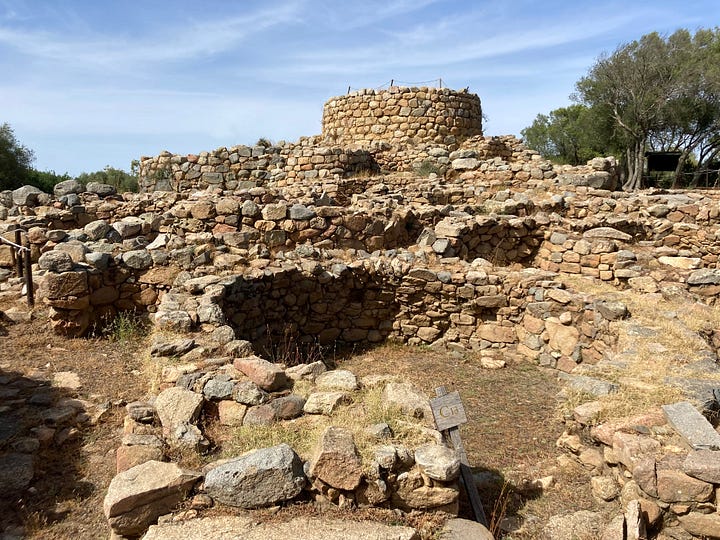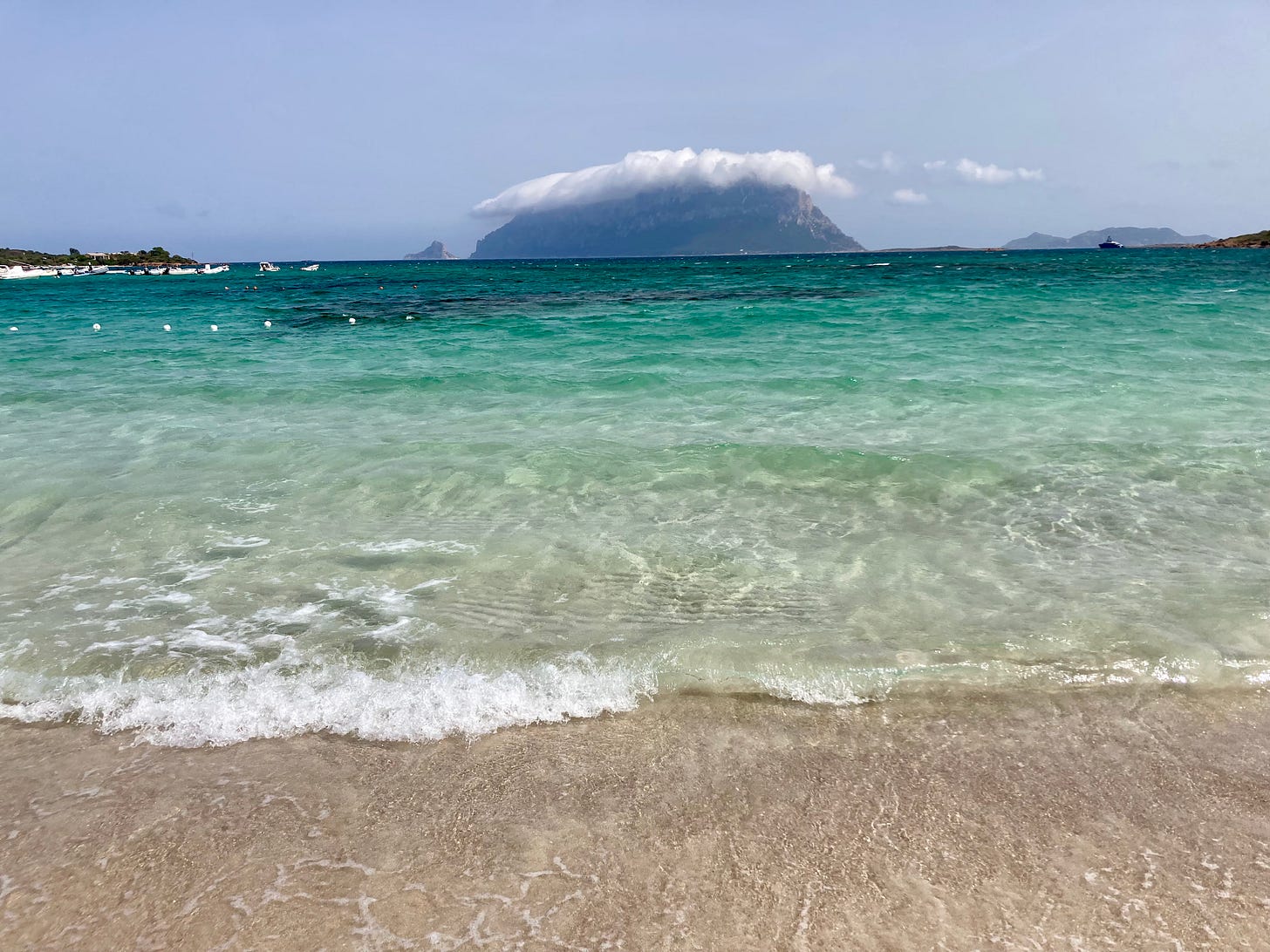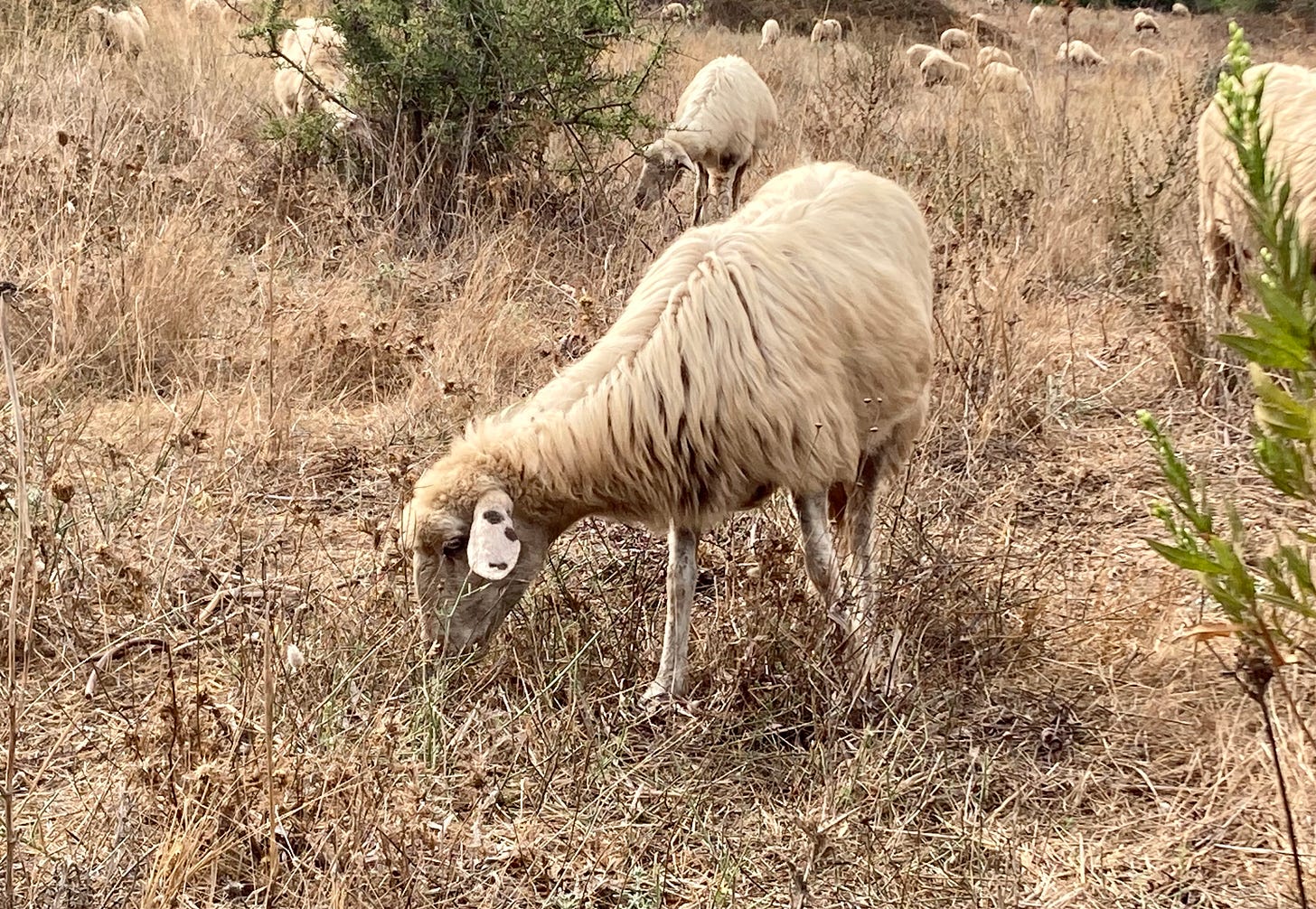Cari amici,
I’m writing to you from Sardegna, my home-away-from-home courtesy of a generous friend whose family has a house here. Primed by my experiences on Capri and the Amalfi and Adriatic coasts, I was looking forward to seeing the famously fantastic colors of the Mar Tirreno. As so often happens with travel, though, things haven’t exactly gone to plan—starting with my arrival.
It’s a smidge over two hours’ drive from Perugia to Civitavecchia, an enormous deep-water port that accommodates ferries the size of horizontal skyscrapers. If you arrive there the recommended three hours before departure, you simply sit in a queue of cars (if you’re bringing yours) for most of that time, and though I’m the type of person for whom on time is late and no amount of early is early enough, I decided two hours in anticipo would suffice. But Fate had other plans for me—and, much more unfortunately, for whoever was in the head-on collision that closed the two-lane road between Monte Romano and Civitavecchia for at least an hour and a half. The arrival of four ambulances and the sight of people wandering along the road next to a lengthy coda of parked cars told me my ferry would depart without me aboard. And so it did—I missed the boat (literally) by five minutes.
After being directed to the biglietteria to rebook, I found the GNV and Grimaldi lines’ ticket windows closed, leaving Tirrenia/Moby as my only option (unless I wanted to wait until evening to book another ticket, which I did not). The next ferry would leave at 11pm. It was now noon. Whatever. Whatever, too, about the ticket that cost three times the price of my original one (partly due to booking a cabin for the overnight trip).
Fortunately the biglietteria’s bar was open, so after fortifying myself with a beer and chips, I decided to pass the time by exploring Civitavecchia. Because there was no place to leave luggage, I set off with my backpack and suitcase. (I’d brought food and bedding with me, so leaving everything in my car meant something would be visible, and given the day’s track record I wasn’t about to risk a break-in.) Suffice it to say that dragging my stuff around a not-very-interesting town—especially after it started raining—grew old quickly, and I waited out the rest of the day whining to friends on the phone and reading in the biglietteria’s muggy waiting area.
We boarded early, at 9pm—hooray! After a 5am wakeup call, I was off the ferry at Olbia and on my way in no time. A beautiful, blue-gated garden greeted me at my friend’s house, promising an idyllic stay. But wait! Evil-minded Fate wasn’t done with me yet.
Following my friend’s instructions, I got the electricity turned on, as well as the boiler in the bathroom. All good, until I tried to light the burners on the stove. Neither the accendigas (gizmo to light the burners) nor the many accendini (cigarette lighters) I found did the trick, but my friend assured me there was probably air in the line and told me to persist. I persisted. The burners remained unlit. I went out and bought a new accendigas. Still nothing, not even the tiniest hiss of gas escaping. After making sure the valve on the bombola was open, I suggested that perhaps the tank was empty. No, my friend said, they last for years, and besides, the gas was working when her father was there the week before. “Yes,” I said, “but this is me. My mother used to swear that a black cloud followed her everywhere, and I think I inherited it.”
It was time to call a guy. Giuseppe showed up the next afternoon, immediately pronounced the bombola empty (che sorpresa!), and went off to get a new one. Problem solved.
But Giuseppe couldn’t solve a more persistent problem: the weather. I enjoyed some beach time and beautiful sea colors on my first day, but since then it’s been nothing but gray. Yesterday I drove along the Costa Smeralda, whose waters, instead of emerald, were the dull gray of an aircraft carrier’s hull. I stopped for a drink at a cliffside bar and sat pondering the view, mentally painting sea and sky in the colors I knew would appear if the sun ever came out from behind a curtain of clouds. On the way there I wandered around Porto Rotondo—gray, as was everything at Liscia Ruja, which I thought was a vista point overlooking the Costa Smeralda but turned out to be its longest beach. After spending an hour there pretending the gray sea waters were sparkling shades of blue and green, I decided to go where gray wouldn’t matter—to one of the many Bronze Age ruins, called nuraghi, that dot the Sardinian hills.
Of course, in keeping with the trip’s theme of failure so far, on my way to Porto Rotondo I’d tried to visit a nuraghe near Olbia. Pushing my little Aygo to its limit up a steep mountain to the supposed site, I found nothing, despite Francesco (my name for my Google maps navigator) announcing I had arrived. (I suggested naming your navigator because it’s satisfying to yell at him by name when he gets things wrong.) Yes, I’d arrived all right—at a dirt track on a mountainside with absolutely nothing in sight but scrubby shrubs and grazing Sarda sheep (at least I think that’s what they are).
The nuraghi around Arzachena, though, exist. I bought a ticket for the Complesso Nuragico La Prisgiona and the Tomba dei Giganti, stone structures that didn’t need sunshine to render them captivating. The nuraghi developed in Sardegna from the 17th century BC, a degree of ancient-ness that blows my history-loving mind. Situated in strategic locations, villages of stone huts with thatched roofs surrounded a central tower (the keep). As you can see from the photos, some blue sky appeared. Go figure. Haven’t seen it since.
The village at La Prisgiona was probably occupied from around 1400 BC to 790 BC, with a later occupation during the time of the Roman Empire. Some of the huts’ uses have been identified—one, with a circular bench, was for meetings of the elders; others were for firing and making pottery. La Tomba dei Giganti (Tomb of the Giants), Coddu ’Ecchju, was built in two stages, in 1800 and 1600 BC. According to a sign at the site, “the cult of ancestors was of great importance in the Nuraghic civilization.” The structures are neither sophisticated nor beautiful, but they are way cool, and touching those stones and imagining what life was like in this long-ago civilization was enough for me.


The drive home involved dodging the astonishing number of Sardi drivers who think a cavallo (straddling the center of the road) is a perfectly fine way to drive, as is going 90 km/hr in 50 km/hr zones, which are everywhere. Except for the main eastern road, Orientale Sarda, the roads, especially in the hills, are narrow, often without shoulders, and occasionally flanked by a drop-off big enough to do serious damage to the underside of a squat car like mine. Fortunately, there aren’t many cars on those roads, and the few times I needed to give way I could do so without destroying my car.
Tomorrow I plan to go to La Maddalena and Caprera for a big dose of history—the great general and patriot Giuseppe Garibaldi (who is, and I love this, my friend’s ancestor) lived on Caprera for the last 26 years of his life. It’s supposed to be sunny, so with luck my history lesson will come with some spectacular views. I’ll let you know next week.
Alla prossima,
Cheryl
© 2023 Cheryl A. Ossola
PS: Thank you to the 55 new subscribers who’ve joined me over the last four days! I’m grateful.
PPS: Some beach oddities: 1) a seagull, the only one I’ve seen, which apparently lacks a normal seagull’s brazen thievery instincts because it stared at someone’s sandwich for a solid ten minutes without moving a feather; 2) his ’n’ hers plastic necklace-type carryalls for phones, in colors that exactly matched their swimsuits; 3) a man in what I guess was a wetsuit but looked more like a heavy jacket, walking in waist-deep water with (I assume) a submersible metal detector and a spade. I couldn’t see if he found anything, though he did dig several times.
Sorry, no book or poetry recommendations this week due to being on the road.
P.S. My book! Which you can buy here or on the usual sites. Another fab option is to ask your local library to stock it. If you read it and like it, please tell your friends and/or leave a few lines of praise on any bookish site. You’ll make me over-the-moon happy. Baci!







Cheryl- I thoroughly enjoyed this piece, though to me the standout element is still the polka dot eared sheep. It’s a show stealer for sure.
You made me laugh and boy did I need to laugh. Been down with a miserable cold and cough for almost two weeks now. Loved, loved, loved the little polka dot eared lamb!